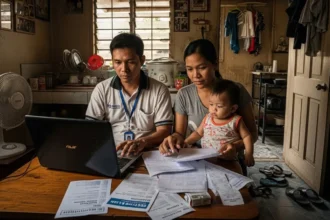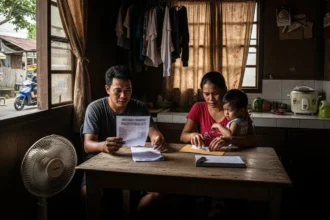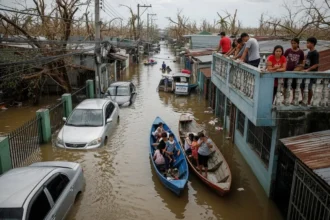The Scroll of Heartbreak: A Generation’s Impossible Dream
You know the feeling. It’s a familiar, heartbreaking ritual. You’re lying in bed, scrolling through your phone, innocently browsing a real estate app. You see a picture of a beautiful house, a cozy little space, and a glimmer of hope sparks in your heart. Then you click on the price. Your thumb freezes. A condo unit, no bigger than a parking space, costs a fortune. A small house in a far-flung subdivision is just as expensive. The prices are astronomical, so high they almost feel like a joke. The smile on your face fades. The hope in your eyes dies a little. This sense of defeat is a powerful one. It’s a shared emotional experience for an entire generation of millennials and Gen Z. We have to ask a difficult, painful question: Why can’t Filipinos buy a house anymore?
- The Scroll of Heartbreak: A Generation’s Impossible Dream
- 📈 The Great Financial Disconnect: Wages vs. Property Prices
- 🗣️ The Kabarkada Confessions: Stories from the Frontline
- 🌍 The Foreign Invasion: A New Player in the Market
- 🏢 The Government’s Promise: A Pag-IBIG Dream or a Red Tape Nightmare?
- ✨ The Silver Lining: Stories of Hope and Sacrifice
- 🤔 FAQs about Homeownership in the Philippines
- The Final Chapter: What Needs to Change
- 🧭 References
This isn’t a story about laziness. This isn’t about a lack of ambition. This is a story about a broken system, a cruel financial joke played on an entire generation. For our parents and grandparents, homeownership was a tangible dream -a goal that could be achieved through hard work and discipline. But for us, for this new generation, that dream has become a fantasy, a cruel joke. The gap between our income and the cost of a house has widened into a canyon that feels impossible to cross. This is not a conversation we can afford to ignore. We need to talk about the truth, the harsh realities, and the painful disconnect that has turned a generational dream into a modern-day nightmare.
📈 The Great Financial Disconnect: Wages vs. Property Prices
The story of the Philippine real estate market is a tale of two eras. There was a time when a house was a tangible goal, achievable with a modest income. The cost of a house was a fraction of what it is today, as was the cost of living. A family could save up for a down payment in a few short years. They could buy a house. They could call it their own. This was the reality for our parents. This was their story.
But that story has changed. The reality is now brutally different. The prices of houses have skyrocketed, increasing exponentially over the last decade. The cost of a small, two-bedroom house today is comparable to the cost of a large, beautiful house from a few decades ago. The dream of homeownership has become a fantasy. A cruel joke. The prices have increased so significantly that they are now beyond the reach of a young professional with a single income. This is the truth of the modern real estate market. It is a reality that is a profound betrayal of an entire generation. We are earning more, but we are also losing more. This is the great disconnect, and it’s a gap that’s getting wider every year.
The Math Problem: A Broken Equation
The income of a young professional is a fraction of what they need to afford a house. The average monthly salary of a millennial or Gen Z is a modest one, just enough to cover basic necessities. It’s not sufficient to save for a down payment. A down payment for a house in Metro Manila can cost anywhere from ₱600,000 to ₱2,000,000. That’s an impossible sum for most, a mountain that would take a decade to climb, and that’s if you don’t spend a single peso on anything else. Furthermore, the interest rates on housing loans, while stable, are still a massive financial burden. A ₱5 million house with a 20% down payment means you still have to take on a ₱4 million loan. The monthly amortization alone can easily be more than a young professional’s entire take-home pay.
The Inflation Nightmare: The Silent Killer
The rising cost of living is the final nail in the coffin. It’s a silent killer, a monster that eats away at our savings. The price of food has gone up, as has the price of gas, utilities, and every other basic necessity. Everything has gone up, everything except our salaries, which have stagnated. This is the harsh truth of inflation. It’s a truth that makes it impossible to save for a down payment. The money we save today will be worth less tomorrow. It’s a brutal reality that makes the dream of homeownership feel like a fool’s errand.
🗣️ The Kabarkada Confessions: Stories from the Frontline
This isn’t just a debate about numbers. It’s a drama about people. It’s about our friends, our siblings, and ourselves. To truly understand the pain, you have to hear it from the frontlines. I reached out to some of my kabarkada (friends) and asked them to share their stories. Their words are a powerful testament to the struggles, fears, and disappointments of a generation. Their stories are a heartbreaking reflection of a shared reality.
Here are their confessions:
- Marie, 29, call center agent: “I’ve been working for seven years. I earn a decent salary, mabuti na lang. But my rent is so high, and every time I see a house for sale, I just want to cry. The prices are so ridiculous. It feels like they are not for us.”
- John, 28, freelance graphic designer: “I earn a good income, but it’s not stable. One month I’m earning well, the next month I have no projects. How can I even think of a down payment? A loan is out of the question for me, nako.”
- Jessica, 30, marketing manager: “My husband and I both have good jobs. We have a combined income of over ₱100,000. But we have a kid. The cost of daycare and school is so high. We can’t even save up for a down payment. Sana all, may parents na mayayaman.”
- Mark, 27, IT professional: “I’m still living with my parents, nakakahiya. I’m trying to save up, but it’s so hard. The price of a condo is so high, and I’m scared to take on a loan. What if I lose my job? The debt would kill me.”
- Carlo, 31, OFW: “I went abroad to work as a seaman for my family. My dream is to buy a house for them. I send home a large portion of my salary. I’m hoping to buy a house in a few years, but the prices are going up so fast. I’m scared I might not be able to afford it, even with my salary.”
Their stories are a powerful and heartbreaking look at the struggle. They are a testament to a generation that is trying its best but is being let down by a system that is not designed to help them. Their frustration is real. Their pain is real.
🌍 The Foreign Invasion: A New Player in the Market
The housing crisis is not just a local problem. It’s a global one. The Philippines has become a hotbed for foreign investment. This influx of foreign money has driven up the prices of properties, creating a new, luxury market. This new market, however, has a dark side. It has made it impossible for young Filipinos to compete. We are now competing with foreign investors. We are competing with wealthy buyers. It’s a war, and it’s a war we are losing.
The drama of foreign investment is a painful one. A developer comes in. They buy a piece of land in a prime location. They build a new, luxury condo. The condo is not for a Filipino family. It’s for a foreign investor, a wealthy buyer. The prices are so high they are a joke. Consequently, the young Filipinos who once dreamed of living in that area are now being pushed out. They are being forced to look for a house in a less developed area, far from their work. This is the truth of urban development. It is a reality that is a profound betrayal of a generation.
The Lumpia Effect: When Properties Become Commodities
Foreign demand for Filipino real estate is a significant force. It has driven up the prices of properties, creating a new, luxury market. This new market, however, has a dark side. It has made it impossible for young Filipinos to compete. A foreign investor can buy a condo with a single payment. They can buy a condo as an investment. We, on the other hand, have to save for years. We have to take on a loan. We have to pay for it for decades. It’s a war. It’s a war that we are losing. This is the truth of the foreign investment. It’s a truth that is a profound betrayal of a generation.
A Tale of Two Cities: The Rise of the Luxury Market
The urban development of Manila is a beautiful thing. The new business districts are a sign of progress, a symbol of a new, modern Philippines. But this development comes at a steep price: the cost of affordable housing. The new developments are not for the young professional. They are for the wealthy, the elite. The new buildings are a symbol of a new, modern Philippines, but also a symbol of a Philippines that has no place for its own young people. This is the harsh reality of urban development.
🏢 The Government’s Promise: A Pag-IBIG Dream or a Red Tape Nightmare?
The government has tried to help. It has created housing programs and agencies like the Home Development Mutual Fund, or Pag-IBIG. The goal of these programs is noble: to make homeownership a reality for every Filipino. The execution, however, is a different story.
The reality of these programs is a painful one. They are a drop in the ocean. The loan amounts are often too low. The requirements are often too strict. The process is often too long and bureaucratic. A young professional with a good credit score and a stable job can still be denied a loan. This is the truth of these programs. It is a reality that is a profound betrayal of a generation. The government has tried to help. But the programs are not enough. They are a drop in the ocean.
The Pag-IBIG Puzzle: A Program of Unfulfilled Promises
The Pag-IBIG Fund is a powerful tool. It has helped millions of Filipinos buy a house. However, for a young professional in 2025, the Pag-IBIG loan is a puzzle. The maximum loan amount is often too low. A young professional can get a loan of up to ₱6,000,000. That’s a good amount. But the price of a house in Manila is often more than that. This forces the young professional to look for a house in a less developed area, far from their work. This is the truth of the Pag-IBIG Fund. It is a reality that is a profound betrayal of a generation.
The Red Tape Nightmare
The process of getting a housing loan is a nightmare. It is a process filled with paperwork and bureaucracy. It can take months, even years. A young professional with a good credit score and a stable job can still be denied a loan. This is the truth of the process. It is a reality that is a profound betrayal of a generation. The government has tried to help. But the programs are not enough. They are a drop in the ocean.
✨ The Silver Lining: Stories of Hope and Sacrifice
The story of the housing crisis is a tragic one, but it’s not without hope. There are young Filipinos who have managed to buy a house. They aren’t rich. They aren’t from a wealthy family. They are people who have been smart, disciplined, and willing to make sacrifices. Their stories are a powerful testament to the Filipino spirit, to a generation that isn’t willing to give up on their dream.
The journey of homeownership isn’t a straight line. It’s a winding road filled with obstacles. But for those who persevere, the dream becomes a reality, a symbol of immense pride.
The OFW Para-sa-Pamilya Story
The most common story of homeownership is the OFW story. A young professional, a millennial or a Gen Z individual, goes abroad, works for years, saves their money, and sends it back home. They buy a house. The house is a symbol of their sacrifice, their love, and their dedication to their family. It’s the truth of the OFW story, and it’s a powerful one.
- Hard Work Abroad: Years of working in a foreign country, often enduring loneliness and challenging conditions.
- Strategic Saving: Sending home a large portion of their salary to be managed by family members for the down payment.
- A Family’s Dream: The house is not just for them; it’s for their family, a testament to their love.
The Side Hustle Saga
Another common story is the side hustle saga. A young professional works a full-time job but also has a side hustle. They work in the evenings and on weekends, saving up their extra income for a down payment. The side hustle is a powerful tool, a way to escape the cycle of a single paycheck and get closer to your dream. It’s a journey of immense hard work and discipline, a testament to a generation that isn’t afraid to work hard for what they want.
- Dual Income: Earning money from a full-time job and a side hustle, giving them more financial leverage.
- Financial Discipline: Having a very strict budget to ensure that the extra income from the side hustle goes directly to savings.
- Patience: Knowing that the journey will be long and arduous, but persevering through it anyway.
🤔 FAQs about Homeownership in the Philippines
Q1: Why Filipinos can’t buy a house anymore? A: Filipinos, especially the younger generation, can’t afford a house anymore because their wages have not kept up with the skyrocketing prices of properties. Additionally, the rising cost of living and inflation make it difficult to save for a down payment.
Q2: How does foreign investment affect the housing market in the Philippines? A: Foreign investment has driven up the prices of properties, especially in urban areas. This has created a new, luxury market that young Filipinos cannot compete with, pushing them out of the city.
Q3: Is the Pag-IBIG Fund a good option for young Filipinos? A: The Pag-IBIG Fund is a good option. It is a powerful tool that has helped millions of Filipinos buy a house. However, the maximum loan amount is often too low for properties in urban areas.
Q4: What is the average price of a house in the Philippines today? A: The average price of a house in the Philippines can vary. A small house and lot in a suburban area can cost anywhere from ₱5,000,000 to ₱10,000,000. A condo unit can cost anywhere from ₱3,000,000 to ₱8,000,000.
Q5: What are some strategies for young Filipinos to afford a house? A: Strategies include working abroad as an OFW, having a side hustle to supplement your income, and buying a house in a less developed area to make it more affordable.
Q6: Is it possible to buy a house with a single income? A: It is possible, but it is very difficult. It requires a lot of discipline. It requires a lot of sacrifice. It is a reality that is becoming more difficult with each passing year.
Q7: How does the cost of living affect homeownership? A: The rising cost of living and inflation eats away at a person’s income, making it difficult to save for a down payment. It is a silent killer. It is a monster that makes it impossible to save.
Q8: What is the emotional toll of not being able to afford a house? A: The emotional toll is immense. It is a feeling of defeat. It is a feeling of helplessness. It is a feeling that your hard work and your dedication are not enough. It is a betrayal of a generation.
Q9: What needs to change to make housing more affordable? A: To make housing more affordable, there needs to be a change in government policy. There needs to be stricter regulations on foreign ownership. There needs to be better, more effective housing programs. There needs to be a change in mindset.
Q10: Is renting better than buying? A: The answer to this is not a simple yes or no. Renting offers flexibility, while buying offers stability. It is a personal decision that should be based on your financial situation and your long-term goals.
The Final Chapter: What Needs to Change
The question of why Filipinos can’t buy a house anymore is not a simple one. It is a complex story of a broken system. It is a story of a generation that has been betrayed. The dream of homeownership, once a tangible goal, is now a fantasy. It is a dream that is being lost to a combination of stagnant wages, a rising cost of living, and a real estate market that is now in a different league. The government has tried to help. But the programs are not enough. The problem is so big that it cannot be solved with a simple program.
For a young Filipino, the journey to homeownership is a difficult one. It is a journey that is filled with immense sacrifice. This journey is profoundly emotional, laden with tears and challenges along the way. But it is also a journey that is a testament to the Filipino spirit. It is a testament to a generation that is not willing to give up.
The dream is still alive. It is a dream that is now being pursued with great effort, discipline, and passion. This is the truth of the Filipino homeownership dream. It is a powerful narrative that embodies a generation’s struggle and unwavering hope.
🧭 References
-
Inquirer Opinion – Unaffordable housing program
-
Sulitrate – Investment boom vs. unmet housing needs 2025
-
Kwebani Barok – Philippines’ housing mirage: too costly for the poorest










